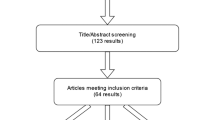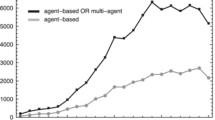Abstract
Many computational tools for the simulation and design of emergency evacuation and egress are now available. However, due to the scarcity of human and social behavioral data, these computational tools rely on assumptions that have been found inconsistent or unrealistic. This paper presents a multi-agent based framework for simulating human and social behavior during emergency evacuation. A prototype system has been developed, which is able to demonstrate some emergent behaviors, such as competitive, queuing, and herding behaviors. For illustration, an example application of the system for safe egress design is provided.








Similar content being viewed by others
References
AEA Technology (2002), A technical summary of the AEA EGRESS Code. Technical Report, AEAT/NOIL/27812001/002(R), Issue 1, http://www.aeat-safety-and-risk.com/Downloads/Egress%20Technical%20Summary.pdf
Ashcraft N, Scheflen AE (1976) People space: the making and breaking of human boundaries. Anchor, New York
Averill J, Mileti D, Peacock R, Kuligowski E, Groner N, Proulx G, Reneke P, Nelson H (2005) Occupant behavior, egress, and emergency communications. NIST NCSTAR 1–7
Batson D (1998) Altruism and prosocial behavior. In: Gilbert D, Fiske S, Lindzey G (eds) The handbook of social psychology, 4th edn. Mcgraw-Hill, Boston, pp 282–316
Billings R, Milburn T, Schaalman M (1980) A model of crisis perception: a theoretical and empirical analysis. Adm Sci Q 25(2):300–316
Braun A, Musse SR, de Oliveira L, Bodmann B (2003) Modeling individual behaviors in crowd simulation. In: Proceedings of CASA: computer animation and social agents, New Jersey, pp 143–148
Bryan J (1997) Human behavior and fire. In: Cote A (eds) Fire protection handbook, 18th edn. National Fire Protection Association, pp 8.1–8.30
Chertkoff J, Kushigian R (1999) Don’t panic: the psychology of emergency egress and ingress. Praeger, London
Cialdini R (1993) Influence: the psychology of persuasion. William Morrow, New York
Crowd Dynamics Ltd (2004) Crowd disasters. November 2004, http://www.crowddynamics.com/Main/ Crowddisasters.html
Epstein J, Axtell R (1996) Growing artificial societies: social science from the bottom up. MIT Press, Cambridge
Fahy R, Proulx G (1995) Collective common sense: a study of human behavior during the world trade center evacuation. NFPA J 87(2):61
Fire Safety Engineering Group (2003) BuildingEXODUS: the evacuation model for the building environment. September 2003, http://www.fseg.gre.ac.uk/exodus/air.html#build
Galea E (eds) (2003) Pedestrian and evacuation dynamics. CMC Press, London
Halcrow Group Ltd. (2003). Pedroute. September 2003, http://www.halcrow.com/pdf/ urban_reg/pedrt_broch.pdf
Helbing D, Farkas I, Vicsek T (2000) Simulating dynamical features of escape panic. Nature 407:487–490
Horiuchi S, Murozaki Y, Hokugo A (1986) A case study of fire and evacuation in a multi-purpose office building. Proceedings of the first international symposium. Hemisphere, Washington, DC, pp 523–532
Johnson S (2001) Emergence: the connected lives of ants, brains, cities, and software. Simon & Schuster, New York
Latane B, Darley J (1968) Group inhibition of bystander intervention in emergencies. J Pers Soc Psychol 10(3):215–221
Le Bon G (1960) The crowd. Viking, New York
Legion International Ltd (2004) Legion. November 2004, http://www.legion.biz/
Low D (2000) Following the crowd. Nature 407:465–466
MacQueen J (1967) Some methods for classification and analysis of multivariate observations. In: Proceedings of 5th Berkeley symposium on mathematical statistics and probability, vol 1. University of California Press, Berkeley, pp 281–297
March J (1994) A primer on decision making: how decisions happen. Free Press, New York
McDougall W (1920) The group mind. Cambridge University Press, UK
Nakamura T, Asada M (1995) Motion sketch: acquisition of visual motion guided behaviors. IJCAI’95 1:126–132
Penn A (2003) Vision, configuration and simulation of static interaction for design. In: Proceedings of 2nd international conference: pedestrian and evacuation dynamics, pp 1–16
Proulx G, Richardson J (2002) The human factor: building designers often forget how important the reactions of human occupants are when they specify fire and life safety systems. Can Consult Eng 43(3):35–36
Quarantelli E (1954) The nature and conditions of panic. Am J Sociol 60(3):267–275
Ramachandran G (1990) Human behavior in fires—a review of research in the United Kingdom. Fire Technol 26(2):149–155
Santos G, Aguirre B (2004) A critical review of emergency evacuation simulation models. In: Proceedings of building occupant movement during fire emergencies, Gaithersburg, Maryland
Shields T, Proulx G (2000) The science of human behavior: past research endeavors, current developments and fashioning a research agenda. In: Proceedings of the sixth international symposium on fire safety science, IAFSS, pp 95–114
Sime J (1986) Perceived time available: the margin of safety in fires. Fire safety science—proceedings of the first international symposium. Hemisphere, Washington, DC, pp 561–570
Society of Fire Protection Engineers (2002) Engineering guide to human behavior in fire. Technical Report
Sommer R (1969) Personal space: the behavioral basis of design. Prentice-Hall, Englewood Cliffs, New Jersey,
Still G (2000) Crowd Dynamics. PhD thesis, University of Warwick, UK
Thompson P, Lindstrom H, Ohlsson P, Thompson S (2003) Simulex: analysis and changes for IMO compliance. In: Proceedings of 2nd international conference: pedestrian and evacuation dynamics, pp 173–184
Waldrop M (1992) Complexity: the emerging science at the edge of order and chaos. Simon & Schuster, New York
Weiss G (eds) (2000). Multiagent systems: a modern approach to distributed AI. MIT Press, Cambridge
Wills R (1998) Human instincts, everyday life, and the brain, vol 1. The Book Emporium, Canada
Wilson G (1993) Logic engineering in public safety. In: Smith R, Dickie J (eds) Engineering for crowd safety, proceedings of the international conference on engineering for crowd safety, London, UK, pp 231–237
Wooldridge M, Jennings NR (1995) Intelligent agents: theory and practice. Knowl Eng Rev 10(2):115–152
Acknowledgments
This research is partially supported by the Center for Integrated Facility Engineering at Stanford University. The authors would like to acknowledge the software support from AutoDesk, Inc.
Author information
Authors and Affiliations
Corresponding author
Rights and permissions
About this article
Cite this article
Pan, X., Han, C.S., Dauber, K. et al. A multi-agent based framework for the simulation of human and social behaviors during emergency evacuations. AI & Soc 22, 113–132 (2007). https://doi.org/10.1007/s00146-007-0126-1
Received:
Accepted:
Published:
Issue Date:
DOI: https://doi.org/10.1007/s00146-007-0126-1




